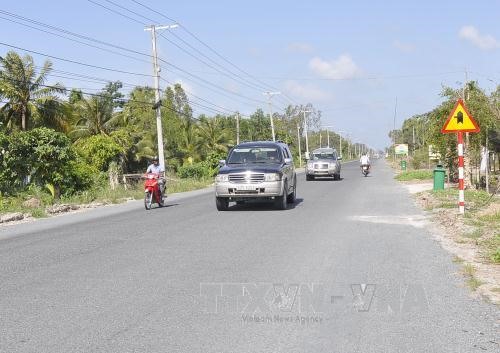 Society
Society

The quality of life for residents in Gò Quao District, which has the largest number of Khmer people in Kiên Giang Province, has improved significantly in recent years because of “new-style” rural areas.
 |
| Kiên Giang Province’s Gò Quao District has built new roads and bridges that have helped improve the quality of life of local residents. — VNA/VNS Photo Lê Sen |
KIÊN GIANG — The quality of life for residents in Gò Quao District, which has the largest number of Khmer people in Kiên Giang Province, has improved significantly in recent years because of “new-style” rural areas.
Construction of infrastructure in the Mekong Delta district such as electricity, clean water and rural roads in recent years has contributed to a better quality of life.
Roads to villages in the district have been paved and trees have been planted.
More than 31 per cent of people in the district are Khmer.
Danh Chách, a Khmer in Thủy Liễu Commune, said that previously his family had planted rice and had an unstable income.
Under the national new-style rural area programme, local authorities encouraged his family to switch to other higher profit crops.
He now takes part in planting trees along roads, and building toilets, rural bridges and roads, which are part of activities of the new-style rural areas.
In the 2016-18 period, the district spent more than VNĐ468 billion (US$20.15 million) from the State budget and the contribution of local residents and businesses for new-style rural areas.
The district targets having its communes meet all criteria of the national new-style rural area programme by the end of next year.
Võ Văn Trà, chairman of the district’s People’s Committee, said that besides participating in activities to build new-style rural areas, many Khmer have applied farming models and used State-provided soft loans to escape poverty.
The district has also provided advanced farming techniques for its major agricultural products such as rice, shrimp and pineapple.
The district’s average income per capita increased from VNĐ38.2 million ($1,640) in 2017 to VNĐ41.6 million ($1,790) by the end of last year, according to the district’s People’s Committee.
The district’s poverty rate fell from 7 per cent in 2018 to 5.3 per cent by the end of last year. The poverty rate of Khmer people in the district now equals the district’s general rate.
Pineapple value
Gò Quao is well-known for its sweet, fragrant pineapple loved by many consumers.
The district has 3,700ha of pineapple, mostly in Vĩnh Phước A, Vĩnh Hòa Hưng Nam, Vĩnh Thắng and Thới Quản communes.
Local authorities have implemented measures to increase the value of the fruit by building a collective brand name for the fruit and encouraging farmers to participate in co-operatives to produce the fruit on a large scale.
In Vĩnh Phước A Commune, pineapple farmers in a co-operative have been given advanced farming techniques to grow and preserve pineapple, and bioproducts to grow “clean” pineapple.
The commune has 2,500ha of pineapple, accounting for 60 per cent of Gò Quao’s total pineapple area.
In November 2017, the National Office of Intellectual Property granted a collective brand name for Vĩnh Phước A pineapple.
Nguyễn Văn Hận, director of the Phước An pineapple – shrimp co-operative in Vĩnh Phước A, said the main source of income of the commune’s farmers comes from pineapples.
Dương Duy Duyệt, deputy head of the Gò Quao Agriculture and Rural Development, said the granting of a collective brand name was the initial step to help farmers establish sustainable farming, expand scale, and create closed production chains.
Companies have also been encouraged to sign contracts with farmers to guarantee outlets for their pineapple, he said. — VNS




